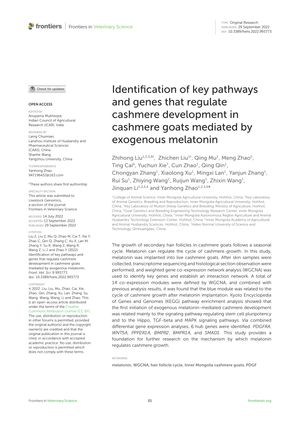Identification of Key Pathways and Genes That Regulate Cashmere Development in Cashmere Goats Mediated by Exogenous Melatonin
September 2022
in “
Frontiers in veterinary science
”
melatonin secondary hair follicles transcriptome sequencing histological techniques Weighted gene co-expression network analysis WGCNA stem cell pluripotency Hippo pathway TGF-beta pathway MAPK pathway PDGFRA WNT5A PPP2R1A BMPR2 BMPR1A SMAD1 hair follicles gene sequencing histology gene co-expression analysis

TLDR Melatonin affects cashmere growth in goats by influencing stem cell and certain signaling pathways.
This study investigated how melatonin affects the growth of secondary hair follicles in cashmere goats, which is a seasonal process. Melatonin implants were used on the goats, and subsequent skin samples were analyzed using transcriptome sequencing and histological techniques. Weighted gene co-expression network analysis (WGCNA) identified 14 co-expression modules, with the blue module being significant for cashmere growth cycle post-melatonin implantation. Key signaling pathways involved in the initiation of cashmere development due to exogenous melatonin were found to be those regulating stem cell pluripotency, and the Hippo, TGF-beta, and MAPK pathways. Six hub genes were pinpointed as central to this process: PDGFRA, WNT5A, PPP2R1A, BMPR2, BMPR1A, and SMAD1. This research lays the groundwork for understanding how melatonin regulates cashmere growth.









